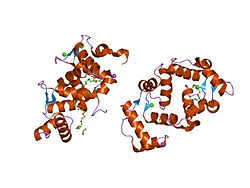Function
NCS-1 regulates synaptic transmission, [8] helps control the dynamics of nerve terminal growth, [9] [10] [8] is critical for some forms of learning and memory in C. elegans [11] and mammals, [12] regulates corticohippocampal plasticity; and enhancing levels of NCS-1 in the mouse dentate gyrus increases spontaneous exploration of safe environments, [12] potentially linking NCS-1 to curiosity. [13]
NCS-1 is a calcium sensor, not a calcium buffer (chelator); thus it is a high-affinity, low-capacity, calcium-binding protein.
Frq can substitute for calmodulin in some situations. It is thought to be associated with neuronal secretory vesicles and regulate neurosecretion.
- It is the Ca2+-sensing subunit of the yeast phosphatidylinositol (PtdIns)-4-OH kinase, PIK1
- It binds to many proteins, some in calcium dependent and some in calcium independent ways, and switches many of the targets "on" (some off).
- Calcineurin (protein phosphatase 2B)
- GRK2 (G-protein-coupled receptor kinase 2)
- D2 dopamine receptor
- IL1RAPL1 (interleukin-1 receptor accessory protein-like 1 protein)
- PI4KIIIβ (type III phosphatidylinositol 4-kinase β)
- IP3 receptor (this activity is inhibited by lithium - a drug used for the treatment of bipolar disorder) [14]
- 3',5'-cyclic nucleotide phosphodiesterases
- ARF1 (ADP Ribosylation factor 1)
- A type (Kv4.3; Shal-related subfamily, member 3) voltage-gated potassium channels
- Nitric oxide synthase
- TRPC5 channel [15]
- Ric8a [16]
- Frq modulates Ca2+ entry through a functional interaction with the α1 voltage-gated Ca2+-channel subunit. [8]
Additionally, NCS-1 is redox-sensitive: under oxidizing conditions it forms a covalent disulfide-linked dimer via Cys38 (dNCS-1). Elevation of free Zn²⁺ (as during oxidative stress) specifically promotes this dimerization, whereas increasing intracellular Ca²⁺ does not. The dimer binds Ca²⁺ in only one EF-hand per monomer, displays reduced α-helicity and thermal stability with increased surface hydrophobicity, and shows ~20-fold higher affinity for GRK1 accompanied by stronger inhibition of the kinase. dNCS-1 can also coordinate Zn²⁺ and exhibits asymmetrical, more flexible subunits. In cells, dNCS-1 is reduced by the thioredoxin system; otherwise it accumulates in perinuclear puncta and aggregates targeted by the proteasome. Notably, NCS-1 silencing decreases susceptibility to oxidative-stress-induced apoptosis in Y79 cells, implicating NCS-1 in redox-regulated survival pathways. [17]
This page is based on this
Wikipedia article Text is available under the
CC BY-SA 4.0 license; additional terms may apply.
Images, videos and audio are available under their respective licenses.




